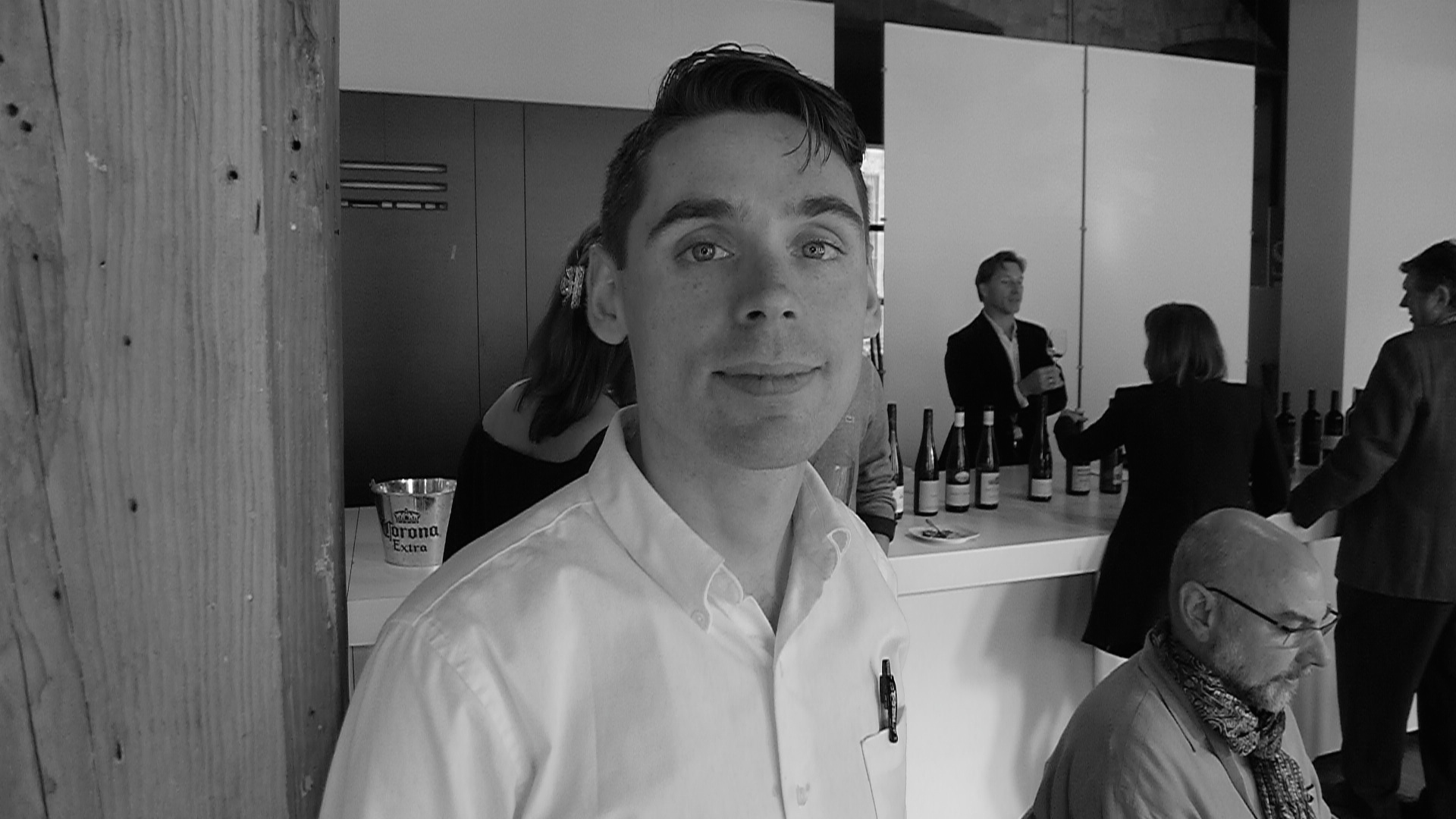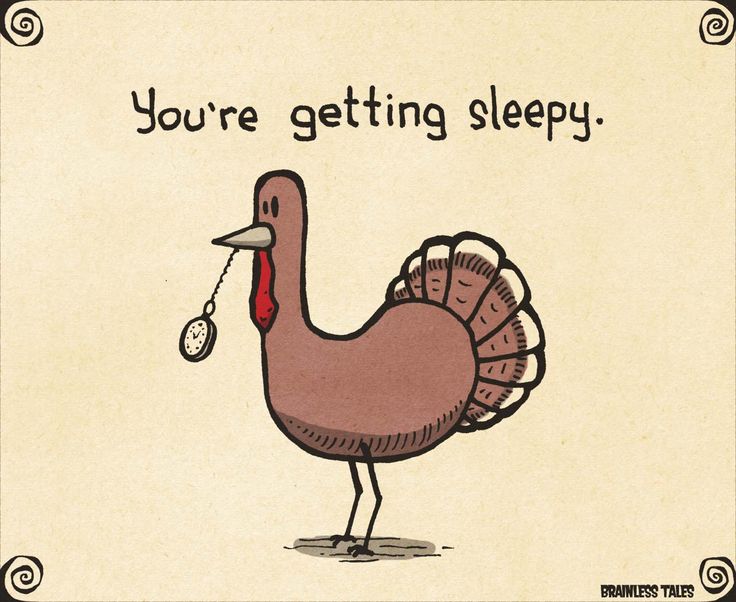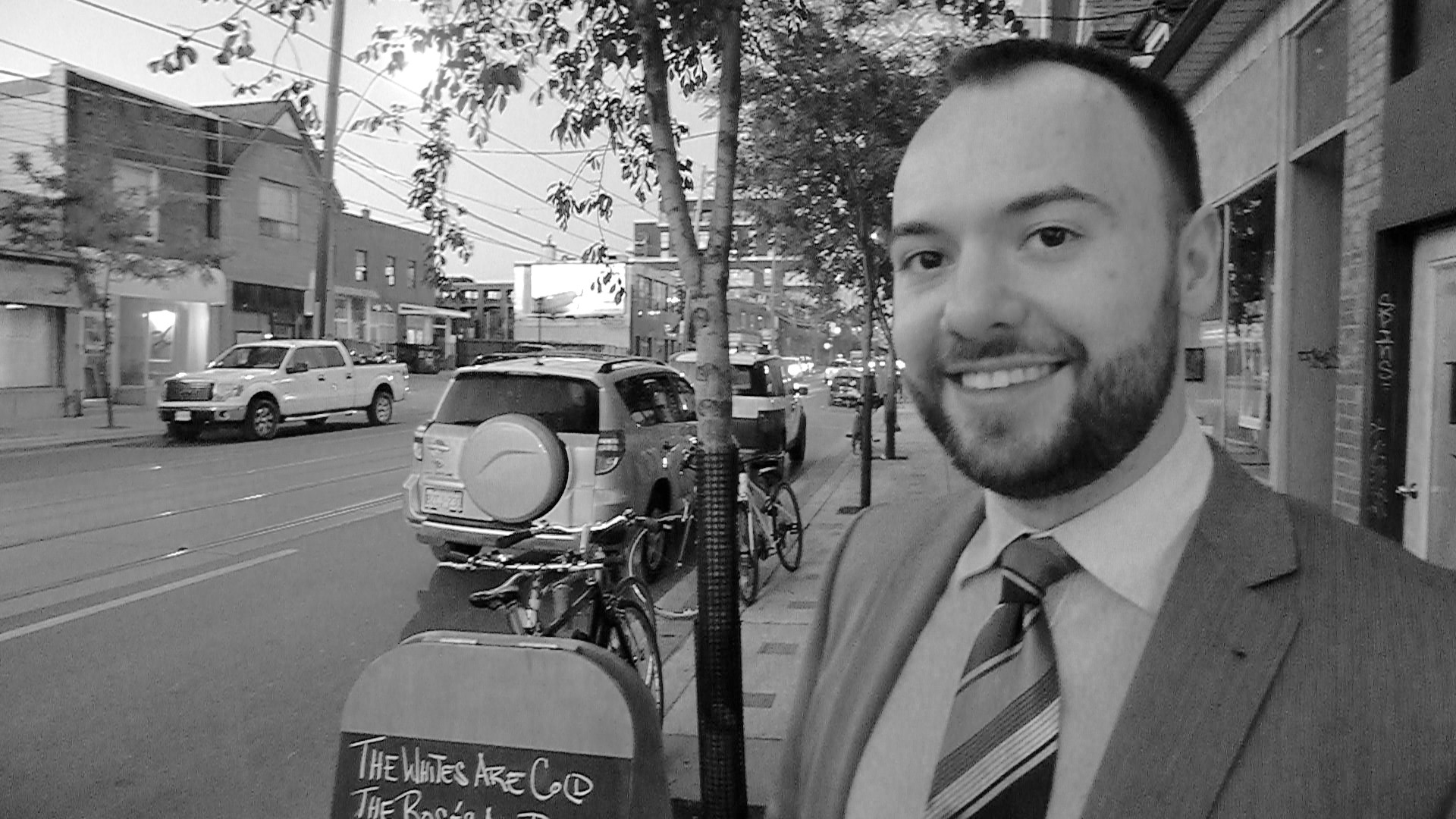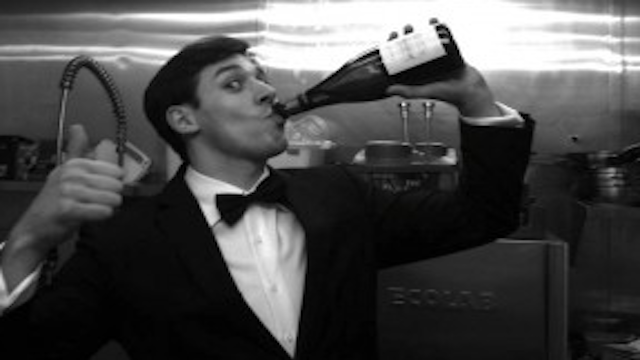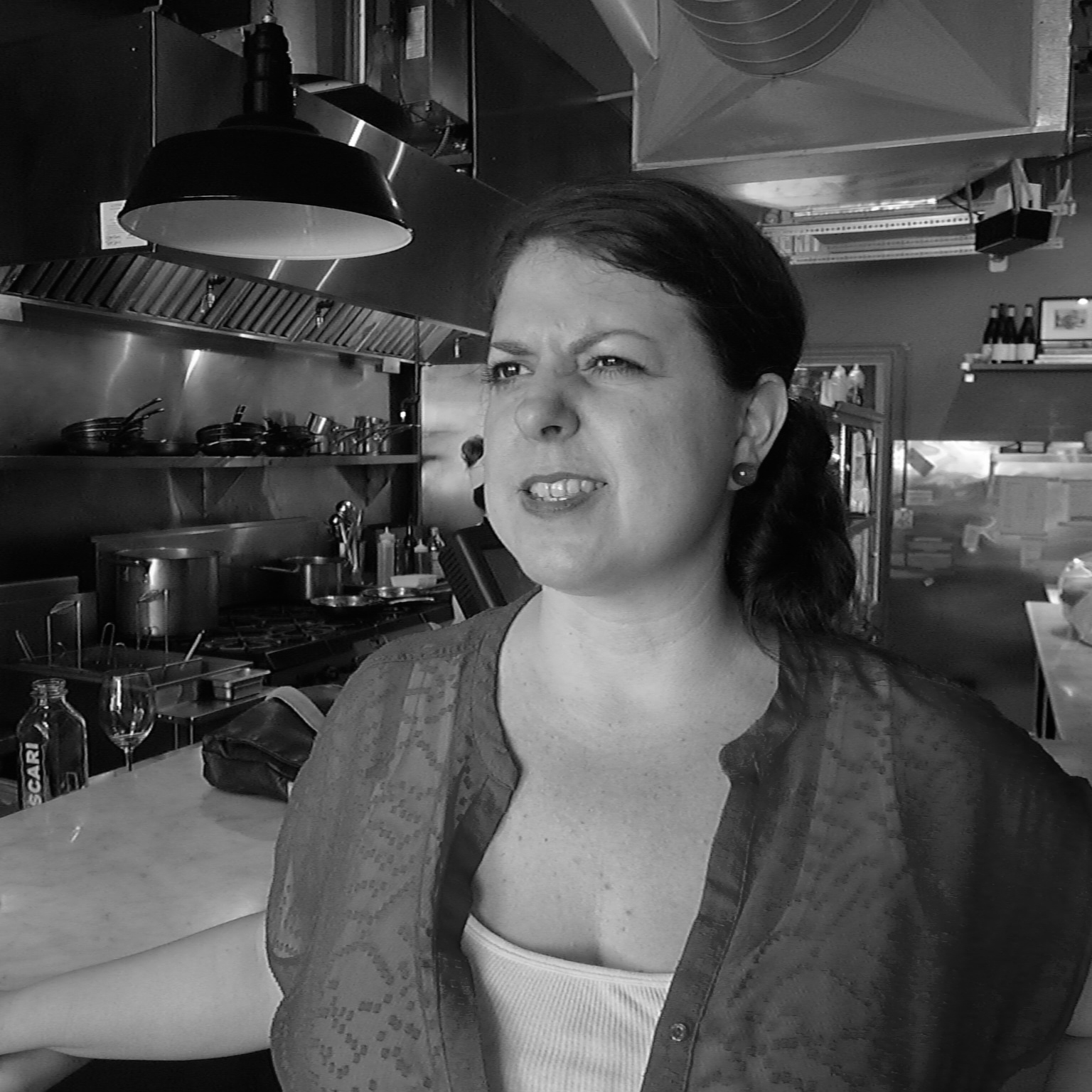In the first of an twelfth (and wildly popular) series, we interview some of the most talented up-and-coming Sommeliers in Ontario (and occasionally elsewhere). A few years back I was flicking through the pages of a locally published periodical and noticed that when it came to Sommeliers it was the same names that seemed to pop up over and over again. I was also becoming gradually cognisant of the fact that we more established wine folks were well and truly “losing our edge” to these young blood Sommeliers. Being well aware of the depth of new talent that was out there I finally decided to get together with a couple of fellow Toronto Sommelier “Old Guard” (Anton Potvin and Peter Boyd) to assemble a line of questioning that would give us an entertaining insight into the minds of these rising stars.
This session we sit down with Bar Isabel‘s Nathan “Nate” Morrell, a multitalented young man who also tries his hand at the wine importation game with his nascent Domaines Eminents agency.
Good Food Revolution: So Nate, what is it that you are doing these days? You are working the floor AND importing wine? How on earth do you manage to do that?
Nathan “Nate” Morrell: I like to keep busy! I work at Bar Isabel as a server and sommelier, and I also co-own a small wine agency called Domaines Eminents with a couple of friends. I really like being able to both sell wine to restaurants though our agency and directly to customers at Bar Isabel. Having that dual role offers me a good perspective on what restaurant buyers like to have on their lists, and also what restaurant guests actually like to drink.
GFR: And what kind of experience and training did you have before doing what you do today?
NM: Most of my experience prior to starting Domaines Eminents was just drinking lots of wine! My partners and I have been lucky enough to travel a little bit in Europe, and really fell in love with the wine and food culture in France and elsewhere. I’ve worked in restaurants for seven or eight years now, and have had the great fortune of working with a number of very knowledgeable, passionate, and generous winos. Gradually I picked up a working knowledge of wine through osmosis, travel, and lots of nerdy reading.
I started working in the front of house at Woodlot, and since then my employers at Chantecler and Bar Isabel have given me lots of opportunities to learn about buying and selling wine in restaurants. I’ve only recently started any formal study of wine in the last year or so though the Court of Master Sommeliers and tasting with MS Bruce Wallner, and hope to take the Advanced Sommelier Exam next year if all goes well.
GFR: How would you describe the wine agency you now helm?
NM: We’re quite a small agency, dealing mainly with direct imports to restaurants and private clients. We’re lucky enough to do business with many of our favourite people and places around town.
GFR: How many wineries are you currently working with, and how do you select who to work with?
NM: Currently we import seven wineries, with a few more on the horizon. All of the wineries we represent are quite small family operations that grow the traditional grapes of their regions, and have a light touch in the vineyards and the cellar. Most are in Europe, though we bring in a little wine from California as well. Often they’re standout producers in somewhat humble appellations, and offer very good value for what’s in the bottle. There’s certainly a range on our price list, but being able to offer some exceptional handmade wines at modest prices is really important to us.
Our first criteria for choosing who to work with is simply deciding whether or not we love to drink the wines. If the wines are delicious, if they convey a sense of place and vintage, if they are very drinkable and balanced, and if they’re of consistently good quality, then we might approach a winery to import them into Ontario. Generally my partners and I will have experience drinking and enjoying a particular estate’s wines before we visit, and then will offer to bring them in if we click with the winemaker and the commercial side of things works out.
Since we all have day jobs and only bring wine in through private order, we have the luxury of being very choosy about who we want to work with. We don’t feel any pressure to bring in wines we don’t love just to pay the rent.
GFR: Now, how do I word this? Have you drunk the Natural Wine Kool Aid? I’m just kidding, how do you feel about the scene?
NM: I have a fair bit to say about this…
Natural wine seems like a pretty controversial topic among in the Toronto sommelier community, but I think the controversy is a little overblown. I’ve often heard people at tastings and other wine events disparage natural wines for being too funky, not delicious, and bad representatives of their terroir. I would say that can be true for some poorly made or stored natural wines, but there are countless wines that one could put somewhere on the natural wine spectrum that are just the opposite.
These days, a lot of totally correct, clean wines from some of the most highly regarded producers in the world could be considered natural wines by all but the strictest zero-sulfur definitions. France has lots of great examples of this – many of the very best producers in the Côte d’Or, Alsace, the Loire valley, and even Bordeaux follow organic or biodynamic practices in the vineyard, ferment using ambient yeasts, use few or no additives, and only use a modest amount of sulfur. We as sommeliers and consumers don’t tend to categorize a lot of these wines as natural, and many of the producers wouldn’t put themselves in that camp, but that doesn’t mean the farming or winemaking is all that different from a lot of the better producers who do consider themselves part of a natural wine movement. A lot of traditional wineries in Europe have worked this way for a very long time, and many more are turning to more sustainable vineyard practices and a lighter hand in the cellar simply because they feel it makes better wine.
Of course, there are plenty of natural wines on our market these days that are dominated by brett, oxidation, and various other faults that I have little interest in drinking, but I could say the same for a lot of conventional wines made with overbearing cellar technologies, aromatic lab yeasts, and additives. Neither of these two extremes tend to make wines that are particularly delicious to me, and I don’t think either extreme makes wines that are very distinctive or expressive of their terroir, which for me is the thing that distinguishes wine from most other beverages.
I think it’s important not to consider the worst examples of indifferent farming and sloppy cellar hygiene in natural winemaking as the sole representatives of an incredibly diverse range of natural wines, which some people in the Toronto wine community do on occasion. Of course, there are people whose tastes run towards more confected wines or to funkier natural stuff, and that’s fine. There’s plenty of room for diversity in wines styles, and I think as Toronto matures as a wine market the controversy will die down and everyone can just drink what they like. For people who are really interested in the classics though, they’re probably already drinking fairly natural wines, whether they or the people who made it acknowledge it or not.
I think that all of the wines we import could be considered natural wines, but not all of the producers would consider themselves as such. My preference runs toward wines that are made with a light hand in the vineyard and cellar, but I’m not doctrinaire about it. If one of our producers needs to spray something to save their crop in a tough year, you won’t hear me complaining, and I’ve certainly drank conventionally farmed wines that were tinkered with in the cellar that I’ve enjoyed very much.
Other things being equal, I’d prefer to drink wine from vineyards that were farmed with care in a sustainable way, and that doesn’t have great deal added or taken away, but most importantly I want it to taste delicious and to taste of when and where it came from.
GFR: What makes for a good agent/supplier in your mind?
NM: For me, a good agent makes an effort to understand what a buyer is looking for and is responsive to their wants and needs. They’re easy to work with on the business end of things, don’t waste your time, and most importantly, they’re genuinely excited about the products they’re selling.
GFR: And what makes for a bad agent?
NM: Bad agents are just the opposite of that. They waste your time by failing to take an interest in what a wine program is all about, and pushing products that clearly aren’t right for the list. It’s also a bummer when agents have good wines but are just difficult to do business with.
GFR: How do you feel about Canadian wines? Any current favourites?
NM: I love a lot of Canadian wines, and think they have a very bright future. There’s a lot of creative energy in Canadian wine right now. Wineries like The Old Third, Pearl Morissette, and Norman Hardie have all made some pretty outstanding stuff.
GFR: What do we do well in Ontario, in your mind, and for your palate?
NM: I think chardonnay is done very well here, as are pinot noir, riesling and traditional method sparkling. There are more and more delicious wines being made from cabernet franc and gamay, too.
GFR: And what do you feel we should give up on?
NM: The wine industry in Canada is still very young, so I think there’s still plenty of room to experiment and see what works. That said big, blockbuster wines and grapes that need a long growing season to ripen properly don’t seem to be very successful here, at least for my palate. Most Bordeaux varieties, for example, don’t do that well in Ontario for my tastes, with the exception of cabernet franc.
GFR: Just as there is from everywhere in the world, there is quite a lot of dreadful wine coming from Ontario also. How do you feel about the issue of people simply promoting something because of it being local, and not because of its quality?
NM: I’m inclined to agree. There’s enough good wine being made here that we don’t have to make excuses for the bad stuff. That said, if I have much more affection for wines that turn out a little funny because they were made by someone who was willing to take risks and try something different in the pursuit of quality or distinctiveness than I do for mediocre wines that turned out that way through indifference or a lack of ambition.
GFR: How aware of wine were you whilst growing up? Were you around wine from an early age?
NM: My parents don’t really drink wine, but there were always modest bottles of wine on the table at holiday celebrations with my extended family while I was growing up.
GFR: Can you remember your first taste of wine?
NM: I remember my grandfather giving me a taste of his Piat d’Or red one Thanksgiving, and I nearly spit it out. I’m not sure if that was because it was unfamiliar or just revolting. I should try it again some time!
GFR: When do you feel children should be introduced to the wonderful world of wine?
NM: I don’t know that there’s a right or wrong age, but I think that gradually introducing kids to wine as a normal part of a meal probably encourages healthy drinking habits.
GFR: When did you first decide that you would like a career in wine?… and was it always with a view to being a Sommelier yourself?
NM: I gradually came to the idea of wanting to work with wine, rather than having a particular moment that I decided it was what I wanted to do. I was cooking for a living, and drinking a lot of good wine, and decided that I’d like to try out working in the front of house to have more exposure to it and become a little more well-rounded. My friends at Woodlot very kindly gave me a shot working in the dining room, and it turned out that I liked serving people and working with wine even more than I had expected. I’ve gradually been working my way toward more wine-focused restaurant positions ever since.
The importing business started concurrently. First of all, I simply had more time after I stopped cooking professionally. My partners and I were lamenting the fact that some of the wines we loved weren’t being imported here, so we decided to do it ourselves. At first the intention was to stock our own cellars as much as anything, but it took on a life of its own.
GFR: So who or what gave you your first insight into the world of wine?
NM: Back when I had my first restaurant gig as a dishwasher at Cowbell, the bartender Pete Hodge gave me a really good introductory book on wine and a very nice bottle for Christmas, and always poured me tastes of cool things, which really helped develop my interest in wine
Later on, my friend Jeff Connell, who was the original baker and wine buyer at Woodlot Restaurant, introduced me to a lot of fabulous bottles, people, and stories that really made me want to pursue a career in wine somehow. He has a background with a lot of fabulous winemakers, particularly in France, who were making very high quality wines that flew under the radar, and continue to do so to some extent. He was a real mentor in terms of teaching me to trust my taste and seek out wines that were really soulful, whether they were popular or not.
GFR: The Sommelier world is notoriously full of pretentious arseholes, and after seeing that film Somm I worry about the emergence of a new Bro culture… I’d love to hear your thoughts?
NM: I’m sure some of that exists here on the margins, but nearly everyone I know in the sommelier community in Toronto seems pretty laid back to me.
GFR: Which wine regions have you had the opportunity to visit?
NM: I’ve taken an annual trip to Europe for the last few years, so I’ve been lucky enough to visit a number of major regions, such as Rioja, Ribera del Duero, Rias Baixas, and Jerez in Spain, Burgundy, parts of the Loire, the Northern Rhone, and the Languedoc in France, and Piedmont, Tuscany, and Campania in Italy. I like to rent a car and make it to some less well-known regions as well, such as Ribeira Sacra, Colares, and the Jura.
The Yarra Valley and the Mosel are on the list for 2016, and of course I get to Niagara and Prince Edward County as often as I can.
GFR: Have you ever made your own wine?
NM: I haven’t. A few winemakers have let me pretend to help out a little in the vineyard or cellar here and there, but that’s it. I would love to work a harvest or even a season at a winery at some point to gain a little more insight into the process.
GFR: And where would you like to make wine (in a pipe dream)?
NM: I don’t know if I could pick one place! Probably the Loire or Beaujolais, but I could live with Galicia or Piedmont.
GFR: So do you prefer to manage people or bottles and why?
NM: I really don’t have to manage people in my current positions, but my coworkers and partners are pretty great.
GFR: What have been your career highs and lows?
NM: Dropping an overflowing bottle of Champagne on a guest was a low point! Visiting the winemakers we work with at Domaines Eminents, and others whose wines I serve is always a fantastic experience. Being able to pass on their enthusiasm and hard work to buyers and to guests in the restaurant is always extremely rewarding.
GFR: Who is, in your mind, a real role model for Sommeliers?
NM: Bruce Wallner, Will Predhomme and John Szabo are all great at sharing their knowledge and experience with younger or newer sommeliers. As far as people currently working the floor in restaurants, it’s always a pleasure to be served by Christopher Sealy, who brings a real seriousness to the profession, and Annette Bruley, Svetlana Atcheva, and Josh Corea, who are really great at transmitting on their excitement about particular wines.
GFR: And for Wine Agents?
NM: There are a bunch of agents in town who I admire and have learned a lot from. Mark Cuff, Nicholas Pearce, and Sharlene Grachan were all really generous with information and advice about starting an agency in Ontario when we were first getting off the ground. I really appreciated their openness and collegiality, and their sense that the wine scene in Toronto was more collaborative than competitive. Sheila Flaherty, Ben Hardy, Marcel Rethore, Bernard Stramwasser, Joel Thompson and many others are great at choosing cool stuff to bring in and passing on their enthusiasm for it.
GFR: Do you still have nightmares about working with wines? I do… regularly… and it usually involves being unable to find bottles in a cellar… and the clock is ticking away… in fact I had one last night!!! And I haven’t been in the role for over five years!!!
NM: Luckily I’ve never had a dream quite like that! Our cellar at Isabel is pretty tiny, so it’s hard to lose things in there. I have had dreams where customers reject bottle after bottle until I wake up.
GFR: Sommeliers famously have their Sundays off… What’s your idea of a perfect Sunday?
NM: On an ideal Sunday all I have to think about is what to eat for dinner and which bottles to open with friends, and which movie to go see with my girlfriend in the afternoon
GFR: Where are your favourite places to dine and drink.. perhaps tell us a hidden treasure of our city?
NM: Oh, there are lots of places I love to eat and drink, though I don’t make it out as often as I’d like. I love going to my former digs at Woodlot and Chantecler, and places like Edulis, The Harbord Room, Dandylion, and The Black Hoof.
I’m not sure about hidden gems, but Le Paradis seems to be below-the-radar for the sort of old-fashioned French food and wine that really appeals to me.
GFR: Do you cook yourself? What’s your favourite dish to cook these days?
NM: I do. I generally keep it pretty simple at home. Roast chicken with whatever vegetables are in season tossed in the roasting pan is a favorite dinner, not least because of how it makes the house smell. Roast chicken also matches with almost any wine I might feel like opening, which is a nice bonus.
GFR: And have you had any cooking disasters recently?
NM: A friend and I tried to cook over an open fire at a camping trip in the fall and it didn’t turn out so well. Some of the food caught on fire.
GFR: Do you feel that there is a good Sommelier community in Toronto?
NM: Yes, I do. There are definitely lots of great and interesting people working in wine here. Sommeliers in Toronto seem pretty well-rounded, too, since there aren’t all that many sommelier-only positions here.
GFR: Do you hang about with other Sommeliers?
NM: Sure, sometimes.
GFR: How do you feel about Toronto as a wine and cocktail city? Where do you go if you need to get your wine or cocktail on?
NM: I think it’s very good and getting better. The LCBO has a deleterious effect on the availability and pricing of interesting wines and spirits, and that probably held us back for a while. The cost problem won’t change until bars and restaurants are able to get wholesale pricing, but agents are doing an increasingly great job at providing interesting stuff, and there are a ton of places around town who are doing a great job with cocktails and wine service.
To go out for a drink, wine bars like Archive, Midfield and Ascari are high on the list for me. I don’t drink all that many cocktails, mostly because they go down too quickly, but sometimes I’ll cozy up to the bar at Isabel after a shift for a quick one, or head over to Bar Raval, Civil Liberties, or Rhum Bar.
GFR: What would you be doing if you were not doing what you are doing today?
NM: I have no idea. I was heading toward a career in academia a long time ago before I got hooked on the food and wine business.
GFR: What are your thoughts on music in restaurants?
NM: I’m for it.
GFR: Do you have a favourite food/wine related scene in a film/movie or show?
NM: The scene when Paul Newman eats fifty eggs in Cool Hand Luke is pretty great, though not very appetizing.
GFR: I know that you have non-industry friends… how do they feel about what you do for a living?
NM: I think they’re into it for the most part. They certainly hit me up for wine recommendations pretty frequently! Some people seem to think it’s just a lot of fun – which it is – but not everyone realizes that it can be a lot of work and long hours as well. Sometimes it’s difficult working opposite hours to those of my girlfriend, but we make it work.
GFR: What are your thoughts on blind tasting wine?
NM: There was a time when I considered it a bit of a party trick, or something that missed the point by taking context out of the picture. More recently though, my appreciation for it has grown immensely. Tasting wines blind really forces you to focus on what’s in the glass, and not your preconceived notions of how certain wines are supposed to taste. I’ve been doing quite a bit of blind tasting lately, and I think it has made me a better, more honest taster of wines, even when I know what I’m drinking.
I certainly wouldn’t want to drink or taste all my wine blind, but I think it’s a valuable exercise.
GFR: Are you a better blind taster with or without a bad hangover? I’m definitely the former…
NM: Definitely without. Blind tasting is as much an intellectual process as a sensual one, so having a cloudy head doesn’t help me very much.
GFR: What’s your current favourite wine region?
NM: I don’t think I could pick one specific region, but the length of the Loire Valley holds a lot of contenders.
GFR: In your mind, as an Sommelier, what is “hot” in the world of wine right now?
NM: I think that balanced, elegant wines from regions that were once better known for very ripe, internationally-styled wines are starting to catch on. A lot of cool stuff from California, South America, South Africa, and Australia is starting to show up in Ontario. Some of these come from newer wineries, but a lot of them are coming from wineries that were quietly making more restrained wines for many years without much recognition.
GFR: And what’s not so hot? What has fallen out of favour?
NM: Sadly, a lot of wines from classic regions like Burgundy, Bordeaux and the ritzier parts of Piedmont are starting to fall out of favour as prices rise and most people – like me – simply can’t afford to drink them anymore.
This has been happening for quite a while, of course, but it seems like more and more other regions are getting caught up in these price hikes as demand for alternatives to the classics increases. I’m already getting priced out of some of my favourite wines from the Jura and Beaujolais, for example.
GFR: When it comes to wine is there anything that you feel is overrated?
NM: Like I said before, there are a lot of wines with a really heavy imprint from their winemaking that get more attention than I think they deserve. This can be because they’re too slick and oaky or too funky from a lack of hygiene in the cellar. These sorts of wines may not be for me, but at the same time, I certainly don’t begrudge other peoples tastes.
GFR: What is your favourite wine pairing right now, something nice and seasonal?
NM: At Isabel we have some very festive seafood towers that I like to pair with godello from Galicia or Bierzo. The wines have a minerally tang that works really well with raw oysters and clams, but enough weight to stand up to richer seafood like crab and shrimp. We have a funky dry aged ribeye on the menu, and I think it pairs pretty wonderfully with aged, old school Rioja, like Lopez de Heredia.
GFR: Okay… three pairings with me on the spot?… but seeing as see are coming up on the holidays, with some traditional Xmas dishes
What would you suggest to pair with them wine or beverage-wise… and why?
1: Bacon sandwiches with brown sauce… you may question this item, but it’s what we have always had first thing on Xmas morning in our household. Seriously.
NM: I’m not exactly sure what brown sauce is, but it sounds pretty rich. Maybe a lager to cut through that?
2. Roast Turkey with all the requisite trimmings?
NM: I think that cru Beaujolais is pretty versatile with all of the different things on the table in a turkey dinner, and Champagne is always a good option. Versatility and lowish alcohol are key with Christmas dinner.
3. Traditional Xmas pudding?
NM: I think PX sherry would be a nice choice to match the richness of the pudding, or a sweeter amaro.
GFR: How open do you find the Bar Isabel clientele to trying new things when it comes to wines?
NM: For the most part they’re very open to it. Our list has a very strong emphasis on Spanish wines, which are unfamiliar to a lot of people, so many are expecting to experiment a little when they come in for dinner. We’re more than happy to help people explore new things and expand their horizons if that’s what they want to do. A surprising number of people will opt for paring sherries with their whole dinner, for example, or spend real money on top-notch mencia.
At the same time, we try not to overdo it. Many people just want a nice glass of wine that tastes familiar while they enjoy the company of friends, so we try to provide easy laterals for people and suggest things that are similar to what they’re used to drinking. The key for me is to be hospitable to those who want to experiment and to those who want to play it safe.

Sommelier Nathan “Nate” Morrell at a Wines Of Austria tasting earlier this year. I don’t think that this fellow like getting his picture taken…
GFR: Do you often drink beers or spirits?
NM: Beer yes, spirits not so much. I’ll have a cocktail or sip on something after dinner sometimes. I enjoy a lot of spirits but they’re just too boozy for me to drink them in any quantity.
GFR: What is your least favourite part of your job as a Sommelier?
NM: Carrying cases up and down the stairs can be hard on our backs sometimes, and LCBO issues can be frustrating. Other than that, I can’t find too much to complain about.
GFR: What is your weapon of choice when it comes to a corkscrew?
NM: I keep it simple. A waiter’s friend with a sharp blade does the trick for the vast majority of bottles.
GFR: And your thoughts on the Coravin system… has it changed the playing field?
NM: I’ve never used a Coravin, but agents have poured me plenty of samples from them, and I’ve had some very interesting glasses from a Coravin in restaurants and wine bars. It seems like a great tool for agents with a limited number of sample bottles, and I certainly appreciate getting to try unusual or expensive glasses without springing for the bottle.
On the flip side, there’s something I really like about enjoying the way a bottle changes with some air, and that isn’t really possible with the Coravin. It has some great applications, but I certainly wouldn’t want to drink all my wine that way.
GFR: Speaking of which, where do you stand on the screwcap vs. cork debate? And how do your customers feel about that?
NM: I have no problem at all with screwcaps for wines that are meant for early consumption. I’ve read that screwcap technology is also getting better for wines that are meant to age, but I don’t think there’s enough of a track record to know for sure.
I open a distressing number of wines that are cork-tainted or otherwise damaged from imperfect corks, but all things considered, I still prefer corks for wines that I want to keep for a while.
GFR: Due to us always being around alcohol, many people in our industry often have quite the increased tolerance for wine/booze, or they develop issues. What is your limit and how do you keep yourself in check?
NM: To be honest, though I probably have a higher tolerance than many people who don’t work in the industry, I’m a bit of a lightweight. I have a reasonably strict “no shots” rule, and I’m prone to the French exit when I start to feel like I’ve overindulged.
GFR: Have you ever been “cut off”? If so, where and when was the most recent time? Did you get cut off at that pool party during the summer?
NM: Not that I can recall, but I suppose I’d be unlikely to remember if I was that tipsy! I was very well-behaved at the pool party, I assure you.
GFR: Do you have a good hangover cure?
NM: No. I’m partial to the Mexican trick of eating the spiciest food I can handle, but it’s more of a distraction than a cure.
GFR: How many wines do you taste in a week?
NM: Upwards of thirty on average for sure, but it varies a lot depending on what’s happening that week
GFR: When tasting with clients do you choose to spit or swallow?
NM: Spit, for sure. I wouldn’t make it through the day otherwise!
GFR: What’s your “house” wine at home?
NM: I buy a case of everything we import, so I tend to drink a lot of whatever we’ve brought in most recently, supplemented by plenty of gamay and riesling, which we sadly don’t bring in yet.
GFR: Most remembered glass of wine ever?
NM: This might hurt my geek cred, but a glass of Veuve Clicquot with some ripe Pied du Vent when I was a university student was pretty memorable. My tastes in bubbles might be a little more rarefied these days, but that definitely showed me that wine and food were things really worth paying attention to.
GFR: What is your perfect glass (or bottle) of wine at the end of a crazy day at work?
NM: After a crazy night, a cold beer usually does the trick.
GFR: And now the cheesy question Nate… If you were a grape varietal which would you be? and why?
NM: Maybe chenin blanc. It takes a little while to warm up to, but it can be pretty charming once you do!
GFR: Thank you for taking the time Nate!… and thanks for doing this.
Edinburgh-born/Toronto-based Sommelier, consultant, writer, judge, and educator Jamie Drummond is the Director of Programs/Editor of Good Food Revolution.
Peter Boyd has been a part of Toronto’s wine scene for over two decades. He has taught the Diploma level for the International Sommeliers Guild, and has been the sommelier at Scaramouche Restaurant since 1993. He also writes about wine, food and pop culture and raises show molerats for fun and profit. He’s also one of the most solid guys in the business.Trust this man. Seriously… he knows his shit and is slowly taking over this city. He just celebrated his 67th birthday!
A well-known and much respected figure on the Toronto food and wine scene for almost twenty years, Potvin has worked in many of the city’s very best establishments including Biffs, Canoe, and Eau. In 2004 Potvin opened his incarnation of the Niagara Street Café, a restaurant that has gone from strength to strength year after year, with universal critical acclaim. Anton spends much of his time traveling and tasting wine and has been ranked highly in consecutive years of the International Wine Challenge. Anton is now GM at DaiLo with Chef Nick Liu.

